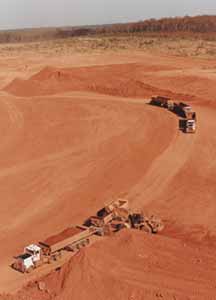Rio Tinto and Alcan announced on July
12, 2007, plans for an agreed acquisition
of Alcan by Rio Tinto for $38.1 billion
in cash. The offer provided Alcan
shareholders with a 65.5% premium over
the company’s all-time high closing share
price prior to May 7, 2007, when Alcoa
started the bidding with a cash and share
offer for Alcan. Rio Tinto’s offer provided
a 32.8% premium over Alcoa’s offer,
based on Alcoa’s share price on July 11.
Later in the day on July 12, Alcoa
withdrew its offer for Alcan. Alcoa
Chairman and CEO Alain Belda said,
“Rio’s offer for Alcan strongly reinforces
our view of the underlying value
in the aluminum industry and its bright
prospects for the future. However, at
this price level, we have more attractive
options for delivering additional value
to shareholders.”
Rio Tinto was not expected to see a
competitive bid for Alcan. Closure of the
purchase is targeted for the fourth quarter
of 2007.
Speculation that BHP Billiton and
possibly CVRD would bid for Alcoa surfaced
almost immediately, with suggestions
that offers could be in the range of
$50 billion. On July 14, The Times
(London) reported that, “Hedge fund investors
have taken large positions in
Alcoa in recent months as speculation
mounts that it will become a target for
one of the large mining groups. A number
of these shareholders have told The
Times that they are demanding meetings
with Alcoa executives to force the company
into a deal.”
 The Gove bauxite mine and alumina refinery
The Gove bauxite mine and alumina refinery
is 100% owned
by Alcan and located in
Nhulunbuy on the Gove Peninsula in Australia’s
Northern
Territory. The Gove refinery is currently
undergoing a $2.3-billion expansion
(known as
the G3 Project) which will increase alumina
production from 2 million
to 3.8 million mt/y.
Combined revenues of Rio Tinto and
Alcan in 2006 totaled $46.1 billion, well
above the $33.1 billion reported by
Anglo American, which was the mining
industry’s leading revenue producer during
the year. Combined revenues of BHP
Billiton and Alcoa during 2006 totaled
$63.2 billion, so a combination of those
two companies would raise the bar for
revenue leadership in the industry to yet
a new level.
Assuming closure of its purchase of
Alcan, Rio Tinto expects to form a combined
aluminum products group called
Rio Tinto Alcan, which would be headquartered
in Montreal, Canada. Current
Alcan CEO Dick Evans would head the
group. Rio Tinto intends to retain its
focus on mining and metals activities
by the divestment of Alcan’s Packaging
division, as jointly agreed with Alcan.
Rio Tinto Alcan would be a global
aluminum industry leader in bauxite,
alumina, power, aluminum metal, and
technology. It would have a strong
pipeline of growth projects. Not factoring
in a possible combination of BHP
Billiton and Alcoa, it would be the
largest global producer of bauxite and
primary aluminum, based on current
production; and with the commissioning
of Gove and the committed expansion of
Yarwun, both in Australia, it would have
the potential to become the world’s
leading producer of alumina.
For Rio Tinto, the acquisition of
Alcan would provide a marked commodity
diversification. In 2006, aluminum
accounted for 10% of its EBITDA, while
copper accounted for 40% and iron ore
accounted for 30%. A pro forma combination
of the companies’ 2006 data
shows bauxite, alumina, and primary
aluminum accounting for 25% of EBITDA
and downstream aluminum minus
Alcan Packaging accounting for 7%.
Copper’s contribution to EBITDA would
be reduced to 30%, and iron ore’s contribution
would be reduced to 23%.

